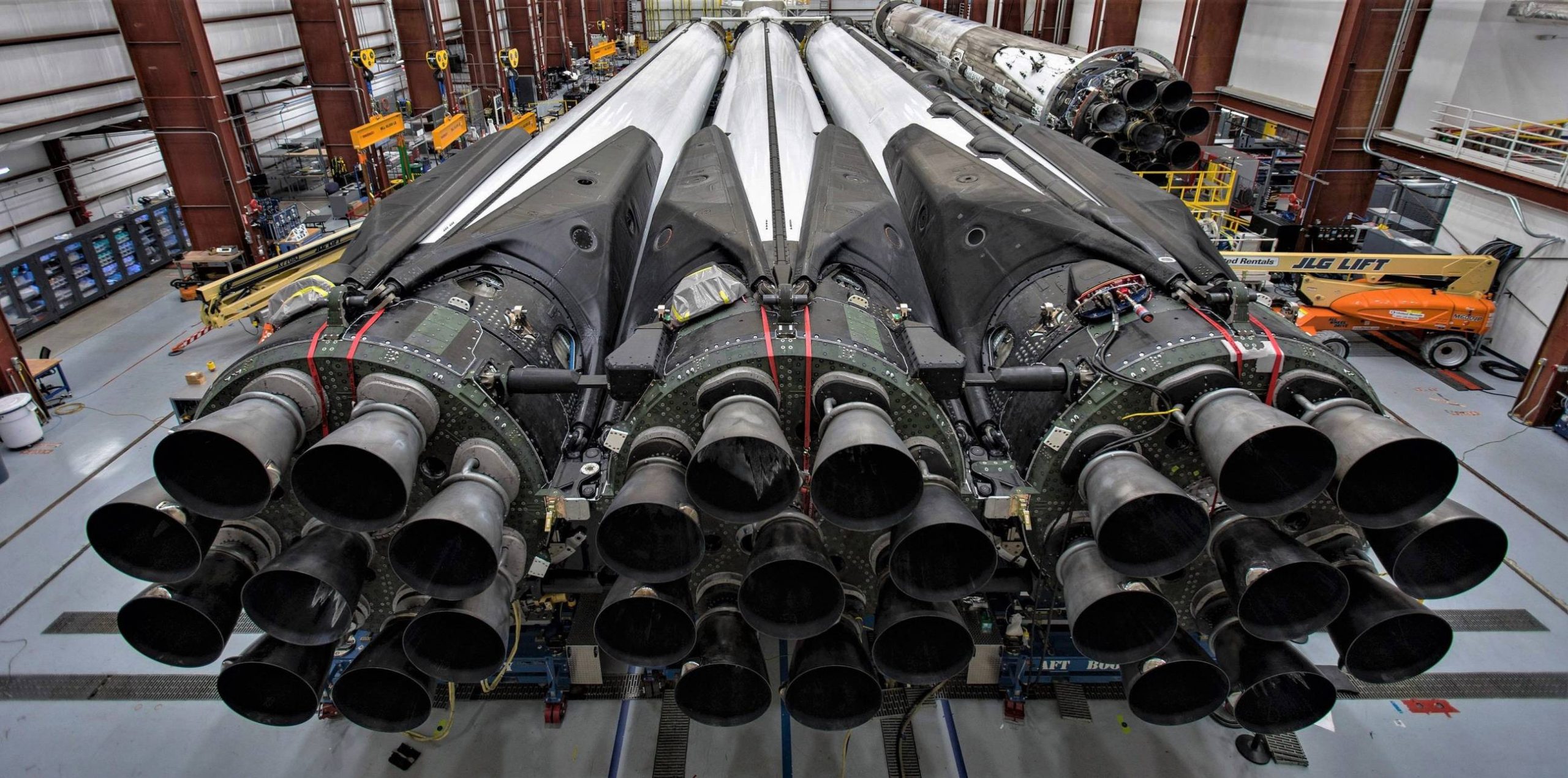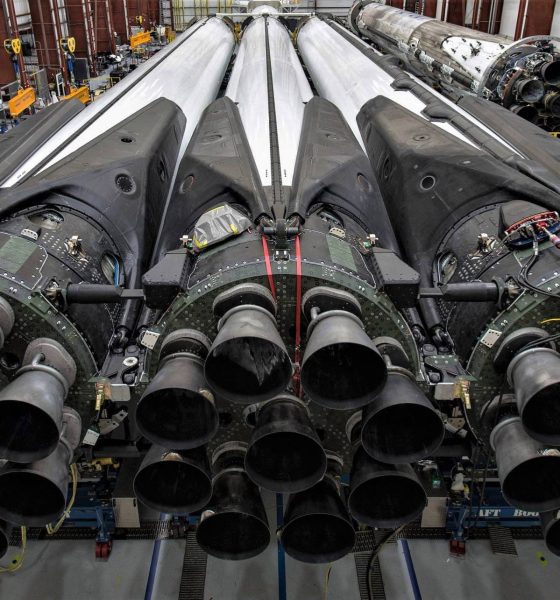

SpaceX
SpaceX reveals Falcon Heavy Block 5 in first official photo, timelapse
SpaceX has revealed the first official media (including a timelapse video) of its Falcon Heavy Block 5 rocket, including one of the most spectacular photos of Falcon Heavy (and the Falcon family in general, for that matter) ever.
Over a period of 24-48 hours in early April, SpaceX technicians and engineers completed Falcon Heavy Flight 2’s final integration, attaching the side boosters to the center core and the rocket’s upper stage to its interstage. After assembled, cranes lifted the massive rocket – likely weighing upwards of 75 metric tons (165,000 lb) – and carefully installed it on Pad 39A’s transporter/erector (T/E), a large mobile structure that houses hold-down clamps and fueling/communications hardware, as well as the ability to lift the rocket vertical and horizontal. Soon after, the rocket rolled out to Pad 39A and performed its first integrated static fire, paving the way for a launch date as early as 6:35 pm EDT (22:35 UTC), April 9th.
Alongside the unique
Offered in 4K resolution, the photo is perhaps the most detailed official look yet at a Block 5 rocket, particularly so for a view of the engine section, octaweb, and heat shielding of not one but four boosters. Immediately noticeable is an intriguing green patina present on each Falcon Heavy booster’s shield heat shield structure, sometimes described (humorously) as the dance floor. Prior to these three boosters, the same structure of other Falcon 9 Block 5 boosters has never featured the same patina, indicating that it is either a distinct modification (improved shielding, perhaps) or – more likely – a vestige of manufacturing that disappears during each Block 5 booster’s first high-speed reentry. In other words, it might be a patina or an anti-corrosion coating that is literally burned off in the process of landing.

Additionally, the complex mechanisms connecting the three Falcon 9-like boosters are also easily visible. Rough visual comparisons between the mechanisms present on Falcon Heavy Flight 1 and 2 suggest that they are largely unchanged. Their ultimate job is to safely, reliably, and repeatedly transfer truly horrifying loads – at times, the majority of the thrust of both side boosters – with as little mass and aerodynamic disruption as possible, all while still successfully separating the three boosters and retracting thereafter. In a press conference shortly after Falcon Heavy’s successful launch debut, Musk repeatedly acknowledged that the additional hardware required – aside from a complete redesign for the center core – was an extraordinary engineering challenge, far harder than he had expected it would be.


Additionally, SpaceX confirmed that the fourth booster present inside 39A’s main hangar was Falcon 9 B1051, the same rocket that launched Crew Dragon into orbit for the first time one month ago. According to the Canadian Space Agency (CSA), B1051 is being refurbished for its Radarsat Constellation Mission (RCM), a trio of satellites planned to launch from Vandenberg Air Force Base (VAFB) no earlier than May 2019. Over the course of the Falcon Heavy integration timelapse, B1051 can be seen rotating on its rocket rotisserie as technicians work to rapidly turn the rocket around for its second launch.

Check out Teslarati’s Marketplace! We offer Tesla accessories, including for the Tesla Cybertruck and Tesla Model 3.

Elon Musk
Elon Musk’s Biggest Revelations on AI, Robots, and the Future of Work from the Moonshots Podcast

Elon Musk’s appearance on the Moonshots with Peter Diamandis podcast was packed with bold predictions, candid admissions, and surprising tech insights. The nearly three-hour conversation covered everything from artificial intelligence to humanoid robots, geopolitics, and the future of work. Here are the top 10 most intriguing takeaways:
-
Aggressive AGI Timeline Predictions
Musk offered a detailed view on when artificial general intelligence (AGI) could emerge, suggesting it may arrive sooner than many expect, emphasizing both transformative potential and risks.
-
U.S. vs. China in the AI Race
He discussed the strategic competition between the United States and China over AI development, noting that geopolitical dynamics will shape how and who leads in the next decades.
-
Future of Job Markets
Musk touched on how AI and automation could reshape employment, predicting massive boosts in productivity alongside potential disruptions in traditional work structures.
-
Clean Energy Transition
A recurring theme was the role of clean energy in future economies, with Musk reiterating the importance of scaling sustainable power generation and storage.
-
Humanoid Robots Are Coming
On the podcast, Musk elaborated on Tesla’s work on humanoid robots, hinting at timelines and applications that go beyond factories to general-purpose assistance.
-
Tesla Roadster “Last Human-Driven Car”
Outside the core discussion topics, Musk teased features of the upcoming Tesla Roadster — calling it “the best of the last of the human-driven cars” and suggesting safety won’t be its main selling point.
-
The Role of AI in Clean Energy and Robotics
Linking AI to both energy optimization and robotics, Musk explained how smarter systems could accelerate decarbonization and task automation across industries.
-
U.S. Innovation Leadership
Musk argued that maintaining American leadership in key tech sectors like AI, space, and robotics should be a national priority, with thoughtful policy and investment.
-
Job Creation vs. Job Elimination
While acknowledging automation’s disruptive effects, he also outlined scenarios where new industries and opportunities could emerge, particularly in AI, space, and advanced manufacturing.
-
Long-Term Vision for Humanity
Throughout the conversation, Musk revisited his long-term philosophical views — including a belief in humanity’s responsibility to become a multi-planetary and technologically empowered species.
Whether you agree with Musk’s optimism or not, the podcast offers a window into the thinking of one of the most influential figures in tech today, in and why his visions continue to spark debate and inspiration.
Elon Musk
Starlink achieves major milestones in 2025 progress report
Starlink wrapped up 2025 with impressive growth, adding more than 4.6 million new active customers and expanding service to 35 additional countries, territories, and markets.

Starlink wrapped up 2025 with impressive growth, adding more than 4.6 million new active customers and expanding service to 35 additional countries, territories, and markets. The company also completed deployment of its first-generation Direct to Cell constellation, launching over 650 satellites in just 18 months to enable cellular connectivity.
SpaceX highlighted Starlink’s impressive 2025 progress in an extensive report.
Key achievements from Starlink’s 2025 Progress
Starlink connected over 4.6 million new customers with high-speed internet while bringing service to 35 more regions worldwide in 2025. Starlink is now connecting 9.2 million people worldwide. The service achieved this just weeks after hitting its 8 million customer milestone.
Starlink is now available in 155 markets, including areas that are unreachable by traditional ISPs. As per SpaceX, Starlink has also provided over 21 million airline passengers and 20 million cruise passengers with reliable high-speed internet connectivity during their travels.
Starlink Direct to Cell
Starlink’s Direct to Cell constellation, more than 650 satellites strong, has already connected over 12 million people at least once, marking a breakthrough in global mobile coverage.
Starlink Direct to Cell is currently rolled out to 22 countries and 6 continents, with over 6 million monthly customers. Starlink Direct to Cell also has 27 MNO partners to date.
“This year, SpaceX completed deployment of the first generation of the Starlink Direct to Cell constellation, with more than 650 satellites launched to low-Earth orbit in just 18 months. Starlink Direct to Cell has connected more than 12 million people, and counting, at least once, providing life-saving connectivity when people need it most,” SpaceX wrote.
Elon Musk
Starlink passes 9 million active customers just weeks after hitting 8 million
The milestone highlights the accelerating growth of Starlink, which has now been adding over 20,000 new users per day.

SpaceX’s Starlink satellite internet service has continued its rapid global expansion, surpassing 9 million active customers just weeks after crossing the 8 million mark.
The milestone highlights the accelerating growth of Starlink, which has now been adding over 20,000 new users per day.
9 million customers
In a post on X, SpaceX stated that Starlink now serves over 9 million active users across 155 countries, territories, and markets. The company reached 8 million customers in early November, meaning it added roughly 1 million subscribers in under seven weeks, or about 21,275 new users on average per day.
“Starlink is connecting more than 9M active customers with high-speed internet across 155 countries, territories, and many other markets,” Starlink wrote in a post on its official X account. SpaceX President Gwynne Shotwell also celebrated the milestone on X. “A huge thank you to all of our customers and congrats to the Starlink team for such an incredible product,” she wrote.
That growth rate reflects both rising demand for broadband in underserved regions and Starlink’s expanding satellite constellation, which now includes more than 9,000 low-Earth-orbit satellites designed to deliver high-speed, low-latency internet worldwide.
Starlink’s momentum
Starlink’s momentum has been building up. SpaceX reported 4.6 million Starlink customers in December 2024, followed by 7 million by August 2025, and 8 million customers in November. Independent data also suggests Starlink usage is rising sharply, with Cloudflare reporting that global web traffic from Starlink users more than doubled in 2025, as noted in an Insider report.
Starlink’s momentum is increasingly tied to SpaceX’s broader financial outlook. Elon Musk has said the satellite network is “by far” the company’s largest revenue driver, and reports suggest SpaceX may be positioning itself for an initial public offering as soon as next year, with valuations estimated as high as $1.5 trillion. Musk has also suggested in the past that Starlink could have its own IPO in the future.








